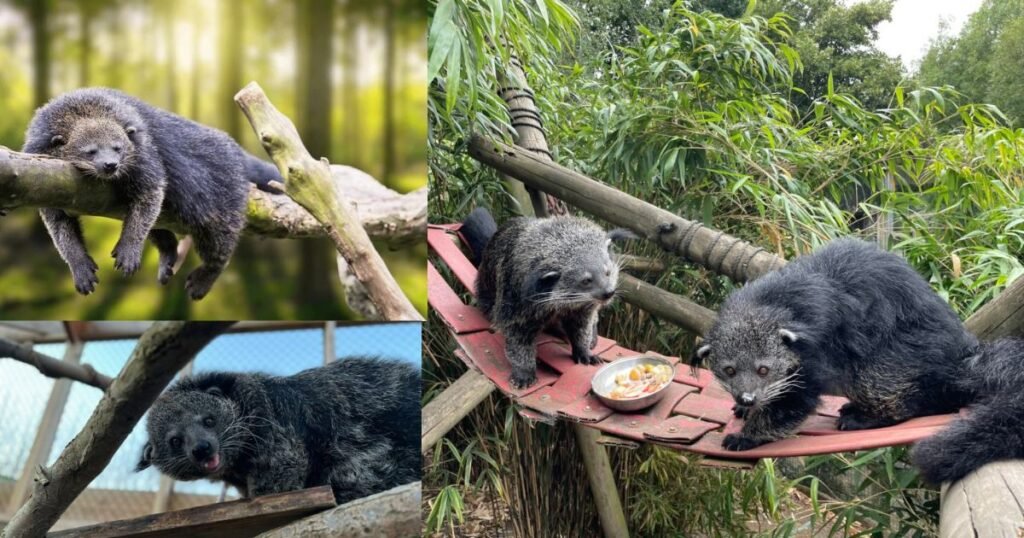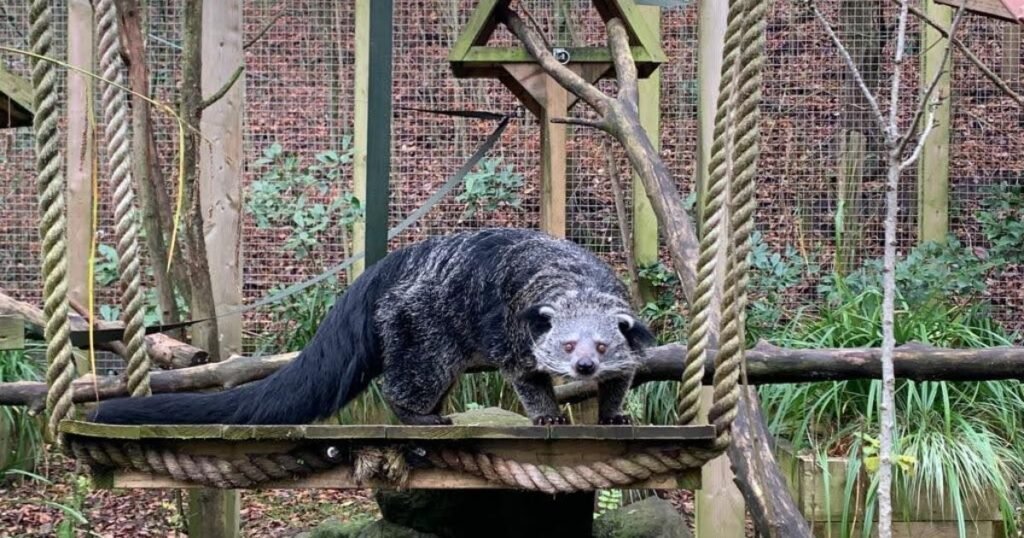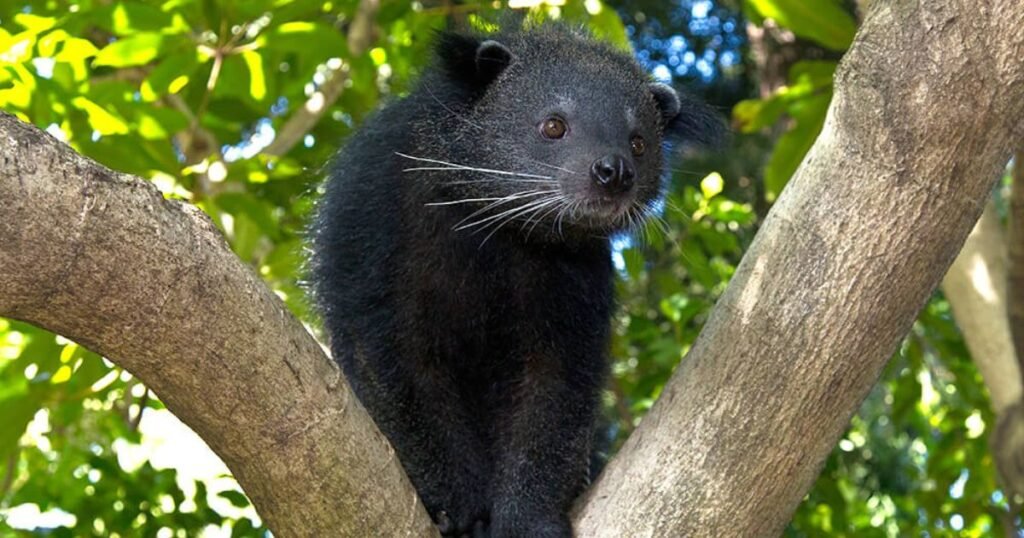Welcome to Animal Vised, your go-to source for fascinating animal information! Today, we’re diving into the captivating world of a unique creature: the binturong. Meet The Binturong Also known as the bearcat, this intriguing animal is sure to capture your imagination. Let’s explore everything you need to know about these remarkable mammals.
What is a Meet The Binturong?
The binturong (Arctictis binturong) is a peculiar mammal native to South and Southeast Asia. Despite its nickname “Bearcat,” it’s neither a bear nor a cat. Meet The Binturong Binturongs belong to the family Viverridae, which includes civets and genets. These animals are known for their distinctive appearance and some truly fascinating characteristics.
Read More: Celebrate World Otter Day

Appearance and Size
Binturongs have a unique look that sets them apart from other animals. Here are some key features:
- Body: Binturongs have a stocky, bear-like body covered in coarse, black fur.
- Face: Their faces resemble those of cats, with small, round ears and distinctive whiskers.
- Tail: Perhaps their most notable feature is their long, Meet The Binturong prehensile tail, which they use for balance and climbing.
When it comes to binturong size, these animals are quite impressive:
- Length: Adult binturongs typically measure 2 to 3 feet (60 to 90 cm) in body length.
- Tail: Their tails add 2 to 3 feet to their overall length.
- Weight: Females are usually larger, weighing up to 44 pounds (20 kg), while males weigh around 31 pounds (14 kg).
Habitat and Distribution
Binturongs are native to the dense forests of South and Southeast Asia. They can be found in countries such as:
- India
- Nepal
- Bangladesh
- Bhutan
- Myanmar
- Thailand
- Malaysia
- Indonesia
- Philippines
These arboreal creatures prefer tropical and subtropical forests, where they spend most of their time in the trees.
Behavior and Lifestyle
Binturongs lead fascinating lives in the treetops. Here are some interesting aspects of their behavior:
- Arboreal Experts: Binturongs are excellent climbers, using their strong claws and prehensile tails to navigate through the forest canopy.
- Nocturnal Nature: They are primarily active at night, resting in tree hollows or dense foliage during the day.
- Omnivorous Diet: Binturongs eat a variety of foods, Meet The Binturong including fruits, leaves, small mammals, birds, and insects.
- Scent Marking: They have scent glands that produce a distinctive odor often compared to popcorn or corn chips!
- Vocalizations: Binturongs communicate through various sounds, including chuckles, howls, and high-pitched wails.
Social Structure: What is a Group of Binturongs Called?
You might be wondering, “What is a group of binturongs called?” Interestingly, binturongs are generally solitary animals, so they don’t typically form large groups. When they do come together, Meet The Binturong usually for mating or when a mother is caring for her young, a small group of binturongs is simply referred to as a “group” or “pair.” There isn’t a specific collective noun for them like “pride” for lions or “pack” for wolves.
Binturong Lifespan
In terms of binturong lifespan, these animals can live quite long lives under the right conditions:
- In the wild: Binturongs typically live 10 to 15 years.
- In captivity: With proper care, they can live up to 25 years or more.
Conservation Status: How Many Binturongs are Left in the World?
Many people ask, “How many binturongs are left in the world?” While it’s challenging to get an exact count, the binturong population is declining. Meet The Binturong The International Union for Conservation of Nature (IUCN) lists the binturong as Vulnerable. Estimates suggest that their population has decreased by about 30% over the last 30 years.
The main threats to binturongs include:
- Habitat loss due to deforestation
- Hunting for fur, meat, and traditional medicine
- Illegal pet trade
Conservation efforts are crucial to protect these unique animals and their habitats.
Are Binturongs Dangerous?
A common question people ask is, “Are binturongs dangerous?” Generally speaking, binturongs are not considered dangerous to humans. They are typically shy and prefer to avoid confrontation. However, like any wild animal, they may defend themselves if they feel threatened. Meet The Binturong Their sharp claws and strong jaws can cause injury, so it’s always best to admire them from a safe distance.
In captivity, binturongs that are raised by humans from a young age can become quite tame and even affectionate. However, they are still wild animals and should be treated with respect and caution.
Meet the Binturong: Videos and Visual Encounters
If you’re eager to see these fascinating creatures in action, there are plenty of “meet the binturong” videos available online. These videos can provide a great visual introduction to binturongs, showcasing their unique appearance, climbing abilities, and behaviors.
Some popular types of binturong videos include:
- Zoo encounters: Many zoos have binturongs and create educational videos about them.
- Wildlife documentaries: Nature programs often feature binturongs in their native habitats.
- Rescue center footage: Meet The Binturong Videos from wildlife rescue centers can show binturongs being cared for and rehabilitated.
- Feeding time: Watching binturongs eat can be fascinating, especially when they use their prehensile tails to help them reach food.
Remember, while videos are a great way to learn about binturongs, nothing beats seeing them in person at a reputable zoo or wildlife center.

Binturong Fun Facts
Let’s explore some interesting facts about binturongs that make them truly unique:
- Popcorn Scent: Binturongs are often called “popcorn animals” because their urine smells like buttered popcorn or corn chips. This scent comes from a compound called 2-acetyl-1-pyrroline, which is also found in popcorn and basmati rice.
- Prehensile Tail: Binturongs are one of the few Old World mammals with a prehensile tail. They can hang from their tails like monkeys, although they typically use their tails more for balance.
- Slow Metabolism: Binturongs have an unusually slow metabolism for their size. This allows them to survive on a diet that’s primarily fruit-based.
- Important Seed Dispersers: As fruit-eaters, binturongs play a crucial role in their ecosystems by dispersing seeds through their droppings.
- Delayed Implantation: Female binturongs can delay the implantation of a fertilized egg for up to nine months, allowing them to give birth when conditions are most favorable.
- Flexible Ankles: Binturongs have very flexible ankle joints that can rotate 180 degrees. This allows them to climb down trees headfirst, Meet The Binturong similar to a squirrel.
- Cultural Significance: In some parts of their range, binturongs are considered sacred animals and are featured in local folklore and traditions.
Binturongs in Captivity
While binturongs are wild animals, they are sometimes kept in captivity for conservation, education, and research purposes. Here’s what you should know about binturongs in captivity:
- Zoos and Wildlife Centers: Many accredited zoos and wildlife centers house binturongs as part of their Asian forest exhibits. These institutions play a crucial role in binturong conservation and education.
- Breeding Programs: Some facilities participate in breeding programs to help maintain genetic diversity in captive populations. These programs can be vital for conservation efforts.
- Education: Captive binturongs serve as ambassadors for their species, helping to educate the public about these unique animals and the importance of conservation.
- Research: Studying binturongs in captivity can provide valuable insights into their behavior, biology, and health, which can aid conservation efforts in the wild.
- Special Care Requirements: Binturongs have specific needs in captivity, including a large, complex enclosure with plenty of climbing opportunities, a varied diet, and environmental enrichment to keep them mentally and physically stimulated.
Binturong Conservation Efforts
Protecting binturongs and their habitats is crucial for the survival of the species. Here are some ongoing conservation efforts:
- Habitat Protection: Efforts to preserve and restore tropical forests in South and Southeast Asia benefit binturongs and many other species.
- Anti-Poaching Measures: Increased law enforcement and community education programs aim to reduce illegal hunting and trapping of binturongs.
- Captive Breeding: Zoos Meet The Binturong and wildlife centers participate in breeding programs to maintain healthy captive populations.
- Research: Ongoing studies help us better understand binturong behavior, ecology, and health, informing conservation strategies.
- Public Education: Raising awareness about binturongs and the threats they face is crucial for garnering support for conservation efforts.
- Sustainable Tourism: Ecotourism initiatives in binturong habitats can provide economic incentives for local communities to protect these animals and their forests.
How You Can Help Binturongs
Even if you don’t live in a country where binturongs are found, there are still ways you can contribute to their conservation:
- Educate Yourself and Others: Learn more about binturongs and share your knowledge with friends and family. The more people know about these unique animals, the more likely they are to support conservation efforts.
- Support Conservation Organizations: Donate to or volunteer with organizations working to protect binturongs and their habitats.
- Choose Sustainable Products: When purchasing products like coffee, chocolate, or palm oil, look for sustainably sourced options that don’t contribute to deforestation in binturong habitats.
- Visit Responsible Zoos: Support accredited zoos that house binturongs and contribute to conservation efforts.
- Reduce Your Carbon Footprint: Climate change Meet The Binturong affects binturong habitats, so taking steps to reduce your environmental impact can indirectly help these animals.
- Say No to Wildlife Products: Never buy products made from wild animals, including binturong fur or parts used in traditional medicine.
- Spread the Word: Use social media to share information about binturongs and the importance of conservation.
Conclusion
Binturongs are truly fascinating creatures that deserve our attention and protection. From their unique appearance and popcorn-scented musk to their important role in forest ecosystems, these “bearcats” are a wonder of the natural world. Meet The Binturong By learning about binturongs and supporting conservation efforts, we can help ensure that these remarkable animals continue to thrive in the wild for generations to come.
Here at Animal Vised, we’re committed to sharing knowledge about amazing animals like the binturong. We hope this article has inspired you to learn more about these incredible creatures and perhaps even get involved in conservation efforts. Meet The Binturong Remember, every small action can make a difference in protecting our planet’s biodiversity.

Read More: Meet The Binturong
Relevant FAQs
1. What does a binturong eat?
Binturongs are omnivores. Their diet Meet The Binturong primarily consists of fruits, but they also eat small mammals, birds, fish, eggs, leaves, and plant shoots.
2. Can binturongs be kept as pets?
While some people do keep binturongs as exotic pets, it’s generally not recommended. Meet The Binturong They have complex needs that are difficult to meet in a home environment, and it’s illegal to own them in many places.
3. Do binturongs smell like popcorn?
Yes, binturongs are famous for their scent, which is often compared to buttered popcorn or corn chips. Meet The Binturong This smell comes from their urine and is used for marking territory.
4. How do binturongs use their tails?
Binturongs have prehensile tails that they use for balance while climbing and sometimes for gripping branches. They can even hang from their tails for short periods.
5. Are binturongs good climbers?
Yes, binturongs are excellent climbers. They spend most of their time in trees and have strong claws and flexible ankles that allow them to climb down trees headfirst.
6. What sounds do binturongs make?
Binturongs can make a variety of vocalizations, including chuckles, howls, and high-pitched wails. Meet The Binturong They also communicate through scent marking.
7. How many babies do binturongs have?
Female binturongs typically give birth to 1-3 cubs per litter. Meet The Binturong They usually have one litter per year.
8. What is the biggest threat to binturongs?
The biggest threats to binturongs are habitat loss due to deforestation, hunting for their fur and meat, and capture for the illegal pet trade.
9. Do binturongs hibernate?
No, binturongs do not hibernate. Meet The Binturong They are active year-round, although they may be less active during very hot or rainy periods.
10. How can I see a binturong in person?
The best way to see a binturong in person is to visit an accredited zoo or wildlife center that houses them. Some eco-tourism programs in Southeast Asia also offer opportunities to see binturongs in their natural habitat, but sightings are rare due to their nocturnal and shy nature.










